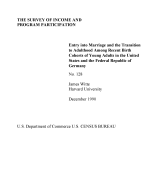Entry into Marriage and the Transition to Adulthood Among Recent Birth Cohorts of Young Adults in the United States and the Federal Republic of Germany
Entry into Marriage and the Transition to Adulthood Among Recent Birth Cohorts of Young Adults in the United States and the Federal Republic of Germany
Introduction
Beginning with Weber, sociologists have identified marital patterns as representative of much of social life: where "... structural constraints and individual choice are not mutually exclusive but interlocking aspects of the mate-selection process" (Haller 1981). Marriages are no longer explicitly arranged to reflect the concerns of larger social units, yet discernible patterns of choice persist—in marital timing, as well as partner selection.
From a life course perspective, these structural constraints organize the processes of educational, employment and marital transition, thereby promoting a particular pattern and pace of transition to adulthood. For those coming of age in the United States in the first half of this century, completing one's education, followed by establishing economic independence through labor force participation and only then entering marriage was a pattern with a certain normative force. This pattern was not simply the result of individuals choosing to experience these events in a particular order. The social and institutional context of early adulthood also encouraged a particular pattern.
However, there is some question as to whether this pattern has the same force for the birth cohorts of the baby boom generation. Modell, Furstenberg and Hershberg (1976) note a tendency toward more complex patterns of transition, in particular, that family and non-family aspects of the process are entwined. Hogan (1978) found that for males in recent cohorts the failure to order one's life course in a normative fashion (completing schooling, beginning a first job, then marrying) was associated, in particular, with college attendance and nonvoluntary military service. Likewise, in a study of American males born between 1944 and 1962, Mare, Winship and Kubitschek (1984) emphasize the "overlapping, interrupted, irregular and varied character of roles and role transitions in a population that is not yet fully integrated into adulthood".
This paper examines life course events experienced by persons born between 1952 and 1967 both in the United States and the Federal Republic of Germany. The emphasis lies on the relationship between labor force integration, the process of completing one's education and moving into the work force, and entry into marriage. A comparative approach is particularly appropriate, as the mode of labor force integration in each country is quite different (formal training tied to specific occupations and well-defined career paths in West Germany vs. on-the-job training with considerable mobility between career paths in the United States).




